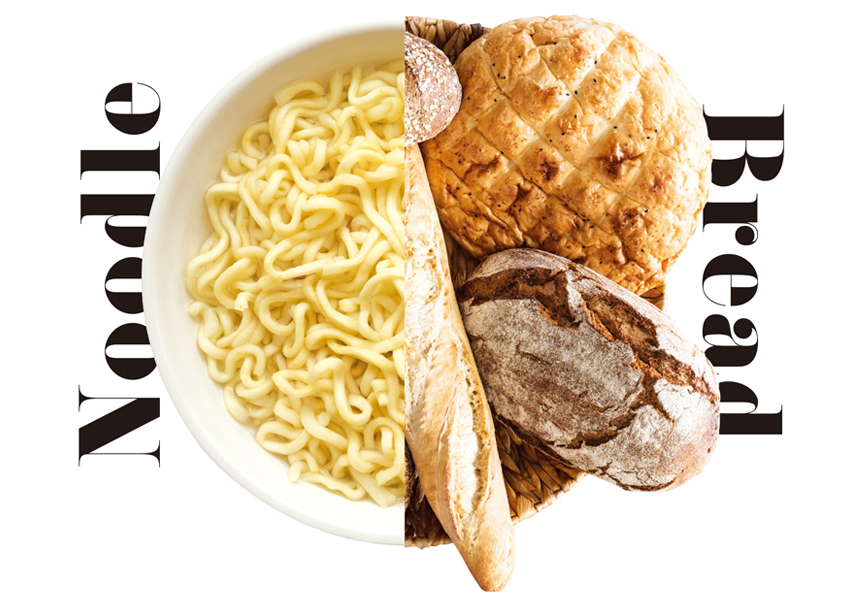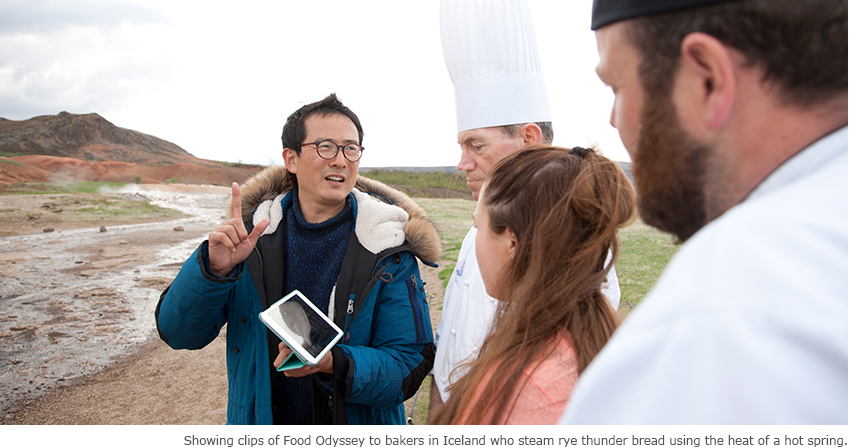

Going Global
at the Dining Table
Celebrating Diversity Through Cultural Exchange
Cultural elements, including food, travel around the world. The journey from continent to continent is more complicated and colorful than what we imagine it to be. In this process, elements such as food, clothing or shelter undergo many changes. They emulate similar elements in other societies, and dominant societies can have an influence over less dominant ones. One remarkable phenomenon is the ability of areas that have been conquered in terms of military power or economic might, to assimilate their conquerors. Where can you witness this? At the dining table!
Written by Lee Wook-jung, KBS Food Documentary Producer

Noodles and Bread
Among the most significant foods in the history of humankind is noodles. In Xinjiang, noodles dating back thousands of years have been unearthed. Why was this discovery made in the heart of Central Asia, right along the Silk Road? Many interpretations exist, perhaps because the area was where people of diverse ethnicities engaged in trade. The Silk Road, a series of caravan routes that connected East Asia and the Middle East, was a widely-used route for bidirectional trade: east to west, and west to east.
The origin of wheat- and flour-based foods can be traced to the West. In the early years of the Han dynasty (206 B.C.-A.D. 220), there were no records of such foods in East Asia. In the West, a typical wheat flour-based food is bread. A plausible hypothesis is that wheat was introduced in East Asia by traders along the Silk Road, and was later turned into noodles. Wheat, used to make bread in the West, took the form of noodles in the East. What, then, is the difference between the two?

Both wheat bread and wheat noodles are made by mixing water and wheat flour to get a dough. Bread is baked in an oven, while noodles are boiled in a pot. Noodles are still formed into the same shapes into which they were made two thousand years ago. They are cut into long, thin strands so that they can be cooked in boiling water in a short amount of time. Bread doesn't need to be cut into strips, since an oven distributes heat evenly over a large area. Wheat flour, a byproduct of exchanges between East Asia and the Middle East and Europe, evolved into noodles and bread depending on the geographic region.
As you can see, the greatest foods in the world weren't invented by top chefs. Rather, they were shaped over centuries through human exchanges and interactions. Noodles, a favorite of many, were also born this way.

Culinary Identity and Heritage
Noodles, thanks to their adaptability, have seeped into various cuisines around the world. Countries have applied different techniques and recipes, giving birth to rice noodles in Southeast Asia and to buckwheat noodles in Northeast Asia. In fact, a new type of noodle dish may be developing even at this moment.
The world I met while making various food documentaries--Noodle Road, Philosophers in the Kitchen: On Hansik, Food Odyssey, and Food Odyssey Kitchen--reflected the saying “You see as much as you know.” Noodles were just the beginning. To understand the world’s food culture, it is worth mentioning the three major events in the history of food. They are the discovery of fire, the start of agriculture, and the Age of Discovery, during which the Old World made contact with the New World. This paved the way for the global dissemination of food cultures.

Last year, during the filming of a documentary series titled “Food Odyssey: Taste of the City,” I visited a farmer’s house in Peru in the Andes. An indigenous South American woman took us to a warehouse. True to the country’s reputation as the origin of potatoes, it was filled with crates of potatoes. From their bumpy exterior and bizarre shapes, I wouldn’t have guessed that they were potatoes. One variety is so difficult to peel that its name in the local Quechua language means “makes the daughter-in-law cry” (uumchuy waqachi). These potatoes were introduced to North America and Europe, but some people called them “Devil’s apples” because of their strange appearance. They may have been met with suspicion in the past, but potatoes today are now key ingredients in many cuisines.
Food is part of history, and human civilization depends on food. It's the tangible accumulation of time, and thus the identity of a group of people. The food culture of each and every country deserves respect and consideration, especially so in this age of globalization.

Gourmets Get a Taste of Tradition
The most common question I received when making the documentary “Noodle Road” was, “Why didn’t you include stories about noodles in Korea?” It’s true that noodles are integral parts of Korean cuisine. However, Korea has a relatively short history of appreciation of noodles. I didn’t want to let my subjective views on Korean cuisine color the overall documentary. If that had happened, I would have failed to adopt a global perspective. The same applies to the case of food. Breaking free from the “ours is best” mentality is essential in opening new doors.
Let’s take a look at an ordinary dining table laid with food. Is it filled only with food that is indigenous to the Korean Peninsula? Unless you’re in a traditional restaurant, the reality is that most dining tables are not 100 percent indigenous. People have toast or coffee for breakfast, rice noodles for lunch, and sushi for dinner. None of those are indigenously “Korean.”
The most popular food in New York can hit the streets of Seoul the following week. When it comes to food, geographical boundaries have blurred with globalization.
“It tastes much better than popcorn. There’s no oil. A very interesting snack.”
- Pierre Gagnaire, holder of three Michelin stars, on the Korean gangnaengi corn snack at the Moran Market
“This is simply delicious! I prefer it to the omelet at Mont Saint-Michel.”
- Yoshiki Tsuji, chairman of the Tsuji Culinary Institute, on bindaetteok savory pancakes at the Gwangjang Market

The above quotes are made by famous chefs on my documentary “Philosophers in the Kitchen: On Hansik.” I couldn’t help but be surprised at how impressed they were by simple snacks sold in traditional markets in Seoul. This demonstrates that the palates of modern gourmets are open to new flavors.
The power of exchange is what makes a dining table more plentiful. This is achieved by having an open mind and a certain respect for other ingredients and cuisines. Of course, some obstacles must be overcome to accept and enjoy unfamiliar foods. If you have a prejudice against a certain ingredient or country, it’s difficult to develop a favorable opinion of the different tastes and varied flavors that exist in that country’s cuisine. The growth in popularity of Korean pop music, films and TV shows in East Asia and elsewhere, has naturally heightened the world’s interest in Korean cuisine. This is an important point to be noted.
The key to enjoying diversity in food is having respect for other cuisines and other peoples. This gives you the courage to try new foods that you’ve never seen before in your hometown. In today’s globalized world, chefs have begun to integrate recipes from around the world into their menus. Dining tables have begun to go global, and this is clearly a trend to be welcomed and embraced. By fostering respect and understanding for diversity, food as an aspect of humanity can be much better appreciated.
Other Articles




Jejudo Island

Carpenter and Important Intangible Cultural Property No. 55

A Universe of Their Own

Signpost to Lasting Peace


without the Beef, Please

the Pulse on the Young
Application of subscription
Sign upReaders’ Comments
GoThe event winners
Go


 April 2018
April 2018


